 Making of Indian Constitution was in progress even before the country attained independence in 1947. The Constituent Assembly of India met for the first time on 9th December 1946 in a preliminary session in New Delhi under the Presidentship of Sri Sachchidananda Sinha. Later on, Dr. Rajendra Prasad, Minister for Food and Agriculture in the Interim Government, was elected permanent Chairman of the Constituent Assembly. After the attainment of Independence on 15th August 1947, the Constituent Assembly assumed legislative powers also. It functioned as the first Indian Parliament after the new Constitution came into effect on 26th January 1950, until the fresh elections were held in 1952 to the new Parliament.
Making of Indian Constitution was in progress even before the country attained independence in 1947. The Constituent Assembly of India met for the first time on 9th December 1946 in a preliminary session in New Delhi under the Presidentship of Sri Sachchidananda Sinha. Later on, Dr. Rajendra Prasad, Minister for Food and Agriculture in the Interim Government, was elected permanent Chairman of the Constituent Assembly. After the attainment of Independence on 15th August 1947, the Constituent Assembly assumed legislative powers also. It functioned as the first Indian Parliament after the new Constitution came into effect on 26th January 1950, until the fresh elections were held in 1952 to the new Parliament.
The Drafting Committee of the Constitution consisted of seven members with Dr. B.R. Ambedkar as its Chairman. The other prominent members of the Committee were Sir Alladi Krishaswami Ayyar, K M Munshi, T.T. Krishnamachari and N. Gopalaswami Ayyangar. Dr. B.R. Ambedkar was the Chief architect of the Constitution of India and he was rightly called the `Modem Manu.` Sri B.N. Rau, a legal authority, served as the Constitutional Adviser to the Constituent Assembly. It took 2 years 11 months and 15 days for the members to pass the draft of the Constitution. It was finally adopted on 26th November 1949 and it came into force on 26th January 1950.
Many Articles of the Constitution of India were borrowed from the Government of India Act of 1935. To a large extent, the Act of 1935 was the basic structure on which the new Constitution was framed. Many ideas were incorporated from the Constitution of Britain, Ireland and U.S.A.
This article is a stub. You can enrich by adding more information to it. Send your Write Up to content@indianetzone.com




















